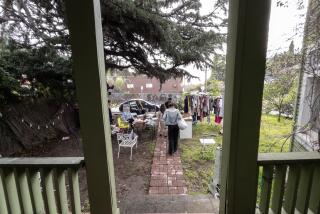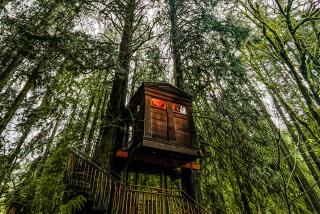In Fredericksburg, Texas, staying in tiny houses brings big pleasures
I felt at home the instant I stepped into my little guest house at Outlot 201, just outside Fredericksburg, and took in the minute living room and adjoining bedroom.
Maybe it was because I was connecting with the Germans who settled this land in the mid-1800s, although my German kin had been in Ohio and Indiana.
Or maybe I was in love with the intimacy of the exquisitely decorated small space with its polished floors, pillow-fluffed king-size bed, sheep-dotted view outside and fresh banana bread in the armoire.
This adorable little bungalow, I surmised, reflected a vernacular architecture found only in the Texas Hill Country.
It began in 1846, after Texas won independence from Mexico and needed to fill the empty landscape with settlers. German immigrants came to Fredericksburg with the promise of 10 acres of land to farm and a small plot in town. Because their farms were as much as 20 miles away on rutted, rocky roads, they couldn’t just drop into town when they wanted.
“They’d come in for Sunday church — church was very important to them,” said Evelyn Weinheimer, archivist at the Pioneer Museum, whose ancestors are among Fredericksburg’s original settlers. “They’d arrive Saturday, shop in the afternoons, socialize with family living in town, worship on Sundays and then head back home Sunday afternoon or Monday.”
They built simple dwellings, called Sunday houses, for their quick town stays.
Some visit San Francisco’s North Beach because it tastes like Italy, and some visit because it howls like the Beat Generation. But the times, they are a-changing.
These tiny houses — built long before HGTV glommed onto the trend — featured one main room downstairs, where the family hung out and ate and the parents slept; a sleeping loft in the half-story above for the kids, usually reached by an outside ladder or staircase; and a front porch for sitting.
Some houses were decorated with gingerbread trim; others were plain. They all were tiny — 15 by 15 feet, on average.
“It’s like how we build weekend homes,” Weinheimer said. “It met their needs for a weekend.”
Stay a spell
Today, you’ll find several originals in the historic district. The Gentemann Sunday House on South Milam Street, one of the oldest surviving (built in 1885-86) is a prime example. Friedrich and Margarethe Gentemann spent weekends here with their seven children, attending nearby St. Mary’s Catholic Church.
The Vogel Sunday House on West Austin Street is another, built in the 1880s for Christian Vogel; his son and daughter-in-law expanded it at the turn of the 20th century.
Those are privately owned, but some Sunday houses are open for overnight stays. The Metzger Sunday House, for example, built in 1898 on West San Antonio Street, has a Victorian flair with a velvet sofa and queen-size bed dominating the main room. The best part? The swing on the airy porch overlooking the quiet, flower-filled street.
The nearby Weber House, built in 1905 on East Creek Street, is sunny and bright with white walls, white-linen bed and even a claw-foot tub. A small garden and porch swings make for an ideal retreat.
For the best understanding, the Weber Sunday House at the Pioneer Museum is a quintessential Sunday house and retains much of its original trimmings. This simple frame house, built in 1904, measures 16 by 20 feet. I surveyed the plank walls, simple cot, table and chairs, and small cast-iron stove for heat and cooking. Let’s just say, it’s not my cozy Outlot 201.
“There was no electricity, no running water,” Weinheimer said, confirming my thoughts.
As cars began replacing buggies in the 1920s, the need for Sunday houses became obsolete as the journey to town became easier. But they were still used.
“I know families,” Weinheimer said, “even when I was growing up in the ’50s and ’60s, and even today, if a family member lives in town, they come to town and stay at that little house.”
Technically, it’s just tiny
As for my Outlot 201 guest house, called Parker House, I learned from owner Darla Smith that it’s technically not a Sunday house despite its diminutive size. It is, after all, two miles from town. Instead, she said, it’s a mini modern farmhouse built on the original “outlot,” as surveyed by the German Emigration Co. The original German family would have lived here on their farm and headed to town on weekends to their Sunday house.
At first I was disappointed I wasn’t experiencing the local architectural history. But then, I realized, I was just the other side of it.
As I sat on the brick patio with a glass of Hill Country wine, taking in the mauve and rose hues of the giant Texas sunset, I thought of the German settlers who once worked this beautiful land and looked forward to jumping into their wagon and trekking to town.
Fredericksburg to this day revels in its German heritage, with German restaurants, breweries and festivals, including one of the greatest Oktoberfests ever. My plan on this evening is to check out Otto’s, a modern take on German fare. But I’m taking the car.
If you go
THE BEST WAY TO FREDERICKSBURG, TEXAS
From LAX, American, Delta, Alaska and Southwest offer nonstop service to San Antonio; Southwest offers direct service (stop, no change of planes); and American, Southwest, United and Delta offer connecting service (change of planes). Restricted round-trip airfare from $257, including taxes and fees. American, Southwest, Delta and United offer nonstop service to Austin; Southwest offers direct service; and American, Southwest, United, Alaska and Delta offer connecting service. Restricted round-trip service from $152, including taxes and fees.
Fredericksburg is about a two-hour drive from Austin,and about an hour and 15-minute drive from San Antonio. Fly into either one and rent a car.
WHERE TO STAY
Cottages at Fredericksburg Herb Farm, 405 Whitney, Fredericksburg, Texas; (844) 596-2302. Fourteen modern cottages evoke the Sunday house tradition, with one main room with a king bed, ceiling fans and rockers on the porch. Modern comforts include a flat-screen TV and high-speed internet. Week nights from $159, weekends from $189.
Outlot 201 Guest Houses, W. 2015 Live Oak St., Fredericksburg, Texas; (830) 456-6555. Three small farmhouse-style guest houses on 10 picturesque acres five minutes from town. From $179 a night; two night-stay required.
Weber House, Hoffman Haus complex, 601 E. San Antonio, Fredericksburg, Texas; (830) 997-6739. Enchanting historic house upgraded with modern amenities, including a soaking tub, full kitchen and screened-in back porch. Doubles from $155 a night. Part of the Hoffman Haus complex of rooms, suites and houses on East Creek Street in downtown Fredericksburg.
WHERE TO EAT
Der Lindenbaum Restaurant, 312 E. Main St., Fredericksburg, Texas; (830) 997-9126. Der Lindenbaum does the town’s German descendants proud with Old World–style schnitzel, bratwurst and amazing desserts, such as apple strudel and Black Forest cake; the beer list features more than 30 German beers. Entrees $10–$30.
Old German Bakery & Restaurant, 225 W. Main St., Fredericksburg, Texas; (830) 997-9084. A casual family-owned restaurant serving currywurst, schnitzels, bratwurst and amazing German-style bread. Open for breakfast and lunch only. Entrees $12–$16.
Otto’s German Bistro, 316 E. Austin St., Fredericksburg, Texas; (830) 307-3336. This cozy bistro serves German cuisine above and beyond the expected, including duck schnitzel, wagyu ribeye steak and pan-seared red snapper. Entrées $30–$60.
TO LEARN MORE
Fredericksburg Visitor Information Center, 302 E. Austin St., Fredericksburg, Texas; (830) 997-6523 or (888) 997-3600.
More to Read
Sign up for The Wild
We’ll help you find the best places to hike, bike and run, as well as the perfect silent spots for meditation and yoga.
You may occasionally receive promotional content from the Los Angeles Times.






